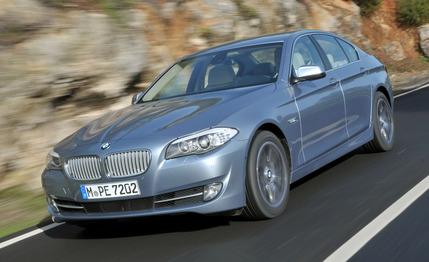
 First Drive Review
First Drive Review
The ActiveHybrid 5 is BMW’s latest contribution to the expanding world of hybrid motoring. It was created in the spirit of environmental good citizenship without sacrificing the ability to get across the intersection and up to speed quicker than most of the other guys. The newest member of the 5-series family not only resolves those seemingly disparate goals but also does so with considerable style and almost no hint that it’s operating with a combination gasoline-electric powertrain.
There are obviously many other alternative-propulsion offerings, even in the mid-size-luxury segment. Lexus has been in the game awhile, and Mercedes is set to debut an E-class hybrid. But for the moment, at least, the ActiveHybrid 5 represents the most sophisticated performance hybrid yet, a seamlessly smooth operator that advances the state of the art in its class.
Power Semantics
Alert BMW faithful might reasonably observe that the company has offered two ActiveHybrids, one based on the 7-series sedan and one on the X6 crossover. The X6 version has already disappeared from the U.S. market for lack of interest.
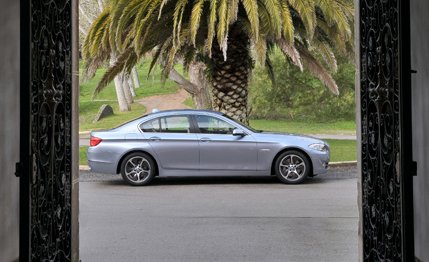

So how is this different?
For one thing, don’t be misled by the word active as employed here. It has nothing to do with mechanical components. It’s BMW’s way of identifying hybrids with Ultimate Driving Machine chops. For another, there are major technical distinctions between these systems; the earlier Actives aren’t as sophisticated as the latest one.
The Basics
The Active 5 is based around BMW’s 3.0-liter aluminum inline-six—DOHC, direct injection, twin-scroll turbo, intercooled, Double VANOS variable valve timing, 300 hp and 300 lb-ft of torque. It is arguably the sweetest six in all of internal combustiondom—smooth, potent, and willing, sweeter still allied with BMW’s eight-speed automatic, the only Active 5 transmission.
As in many other hybrids, the IC engine is augmented by an electric motor, this one rated for 54 hp and 155 lb-ft. When the driver demands everything the system has to give—335 hp—the motor adds its punch to the IC output, and the 5’s speedo needle rotates clockwise with gratifying haste.
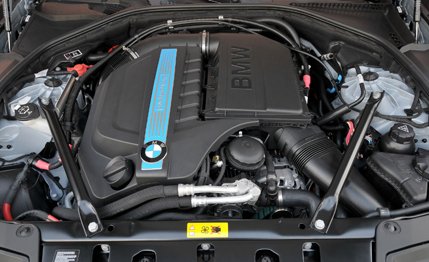

So far this is pretty much standard Hybridology 101. Now for some distinctions.
Hybridology 5 (Graduate Level)
This is the first time BMW has hitched its inline-six to a hybrid mission, something that’s also true of the eight-speed auto. An optional “sport” version of the latter offers faster shifts than the hybrid’s standard box. Both use an integrated, clutched electric motor.
Unlike BMW’s bigger hybrids, the hybrid 5 is capable of operating as a pure electric for up to 2.5 miles and at speeds up to 37 mph. The motor is fed by a lithium-ion battery pack residing in the trunk, where it reduces luggage capacity from 14 cubic feet to 8.5. The battery pack also powers the car’s air-conditioning compressor. A conventional 14-volt electrical system takes care of other functions—lights, turn signals, etc.
As in other systems, the motor becomes a generator during deceleration. But unlike some hybrid systems, here when the driver takes his foot off the throttle and coasts, the system disengages and shuts down the engine entirely, eliminating pumping losses and mechanical drag associated with the drivetrain.
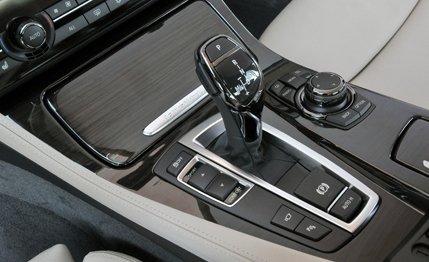

Yet another intriguing feature: The nav system (standard) syncs with the hybrid control electronics and optimizes operation based on route topography and urban versus rural road conditions.
The Active 5 adds an “eco pro” mode to its standard Driving Dynamics Control setup. It’s essentially the same as comfort in terms of dynamic character, but it also optimizes operation of the hybrid system to further improve fuel economy.
And what will optimal fuel economy be? Although the Active 5 reaches showrooms this month, BMW didn’t have final EPA numbers during our preview drive. Best guess by BMW engineering staff is that they will be about the same as the 528i automatic’s—23 mpg city and 34 highway.
On the Road
Like other 5-series Bimmers, the Active 5 is poised, balanced, and fairly responsive. In terms of traditional performance, it’s hard to imagine anyone being dissatisfied. The hybrid system adds about 300 pounds to the car’s curb weight compared with a standard 535i, so we expect the more powerful hybrid will lag behind that car slightly in the trip to 60 mph. Figure about 5.7 seconds versus the automatic 535i’s 5.4.
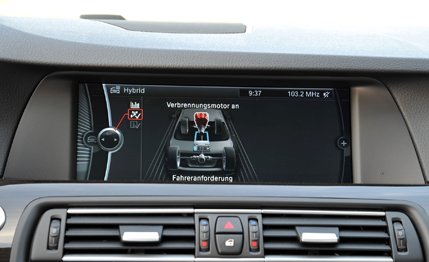

More remarkable, though, is the system’s transparency. Its engine stop/start feature is essentially undetectable, and when the driver takes his foot off the brake, the car will creep forward on electric power until directed to pick up the pace. On back roads and expressways, the coasting function comes into play at speeds up to 100 mph. When the car is rolling on a long downhill with relaxed throttle, the only clue to engine shutdown and disengagement is a glance at the tach, which drops to zero. A dashboard graphic provides instant info on what the system is doing and is of course designed to reinforce thrifty driving.
About the only dynamic criticism one might make is that throttle response is a little soft in eco pro mode, but anyone making that complaint probably doesn’t want a hybrid anyway.
Money
The base price for all of this is $61,845. It’s not the most expensive entry in the 5-series lineup—the eight-cylinder versions (the 550i and the M5) cost more. But it’s $8450 more than a 535i with the eight-speed auto. That’s a lot of extra green for the green. So if the price seems a little too dear, stay tuned for the 3-series hybrid, which will feature the same powertrain.